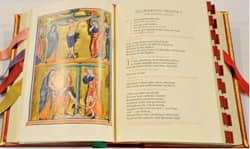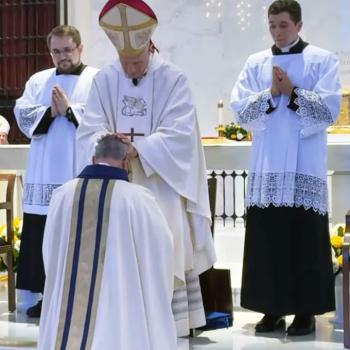 Editor's Note: This is the first of a four-part series that explores the new translation of the Roman Missal, which will first be used in parishes on the First Sunday of Advent. In this article, the author reviews some of the changes to the responses of the people.
Editor's Note: This is the first of a four-part series that explores the new translation of the Roman Missal, which will first be used in parishes on the First Sunday of Advent. In this article, the author reviews some of the changes to the responses of the people.
It is the most significant development in the Mass—for English speakers—since the Second Vatican Council.
The new translation of the Roman Missal (3rd edition), is coming to our local Roman Catholic Churches on November 27, the First Sunday of Advent. Long in coming, this English translation follows the revisions made to the official Latin missal, Missale Romanum, announced by Blessed John Paul II in the Jubilee Year, 2000.
The way we pray defines us, not just as individuals, but also corporately as a Church. A well-known Latin axiom Lex orandi lex credendi reminds us that the law of prayer is the law of belief, and indeed, our way of prayer shapes and typifies our beliefs. This is why the celebration of Eucharist is so central to the worship of Roman Catholics; our entire Creed comes together in the Mass.
To that end, bishops and clergy, Scripture and Latin scholars, poets, musicians, liturgists, and others have spent years revising a dozen drafts leading up to the release of this new translation, and the finished product offers a wonderful opportunity for renewal within the entire English-speaking Church—a chance to delve into what we say when we pray, with rekindled concentration.
It's important to note that while some of the words we pray will change, the familiar Rite and Order of the Mass will not.
Within the audible or spoken parts of the Mass, we have the priest's prayers and the prayers of the people. Changes are coming to both. They reflect careful scholarship that renders more accurately the power, beauty, majesty, and doctrinal precision of the original Latin text promulgated under Pope John Paul II.
The majority of the changes, however, will be within the portions of the Mass that the priests pray—changes to collects, prefaces, and certain words within the Eucharistic prayers. Different prayers will enter the liturgical calendar during holy days, and new saints' memorials will be added to the liturgical cycle.
Priests will need time to study and pray with these new texts prior to Advent. That training is already underway in most Catholic dioceses. This calls our priests into a reflective and receptive posture. They will daily have to absorb the new Mass text's meanings, and internalize them. Let us pray that each priest may become one with the mysteries he celebrates.
For ourselves—as laity and religious who populate the pews—let us be open to the challenge to delve more deeply into the Mass. No longer, in the short term, will we be able to rely on the prayers, by rote. We must enter anew into our participation of the Mass. We should welcome these new prayers as opportunities to be more in tune with God, as well as with the worldwide Church.
As this is the first of a four-part series, let's begin by looking at just a few of the changes coming to the responses of the people.
"The Lord be with you."
"And with your spirit."
At three points in the Mass—the Greeting, the Sign of Peace, and the Concluding Rite—the priest greets or calls the people to prayer with these words: "The Lord be with you." The current response is: "And also with you."
The new response on the part of the people will be "And with your spirit."
This new reply is a more direct translation from the official Latin text.
Here is the Latin:
Priest: Dominus vobiscum.
People: Et cum spiritu tuo.
The 1970 translation:
Priest: The Lord be with you.
People: And also with you.
The new translation:
Priest: The Lord be with you.
People: And with your spirit.
It is interesting to note that the new English translation, in this case, is catching up to the French, Italian, Spanish, German, and other translations, which were always more precise. This new rendering will allow the English-speaking world to recapture this ancient exchange that dates back to the 3rd century.





